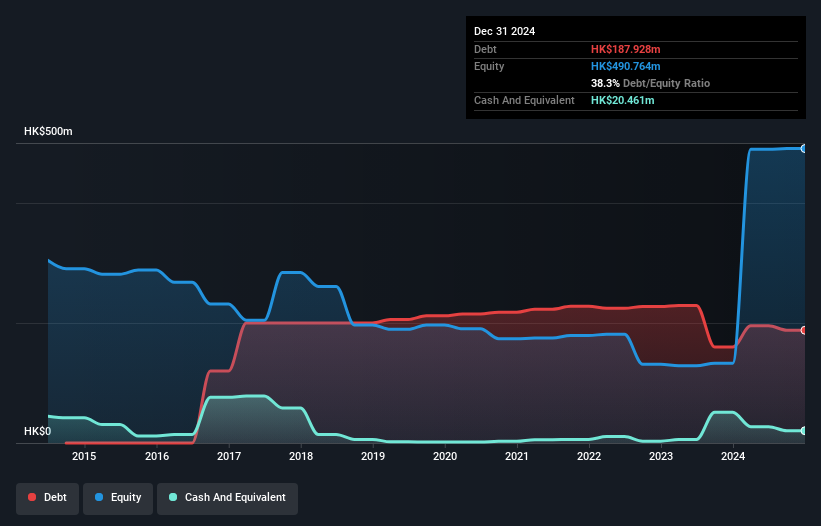
Warren Buffett famously said, 'Volatility is far from synonymous with risk.' So it seems the smart money knows that debt - which is usually involved in bankruptcies - is a very important factor, when you assess how risky a company is. We can see that China Asia Valley Group Limited (HKG:63) does use debt in its business. But the real question is whether this debt is making the company risky.
We've discovered 3 warning signs about China Asia Valley Group. View them for free.What Risk Does Debt Bring?
Debt and other liabilities become risky for a business when it cannot easily fulfill those obligations, either with free cash flow or by raising capital at an attractive price. In the worst case scenario, a company can go bankrupt if it cannot pay its creditors. However, a more common (but still painful) scenario is that it has to raise new equity capital at a low price, thus permanently diluting shareholders. Having said that, the most common situation is where a company manages its debt reasonably well - and to its own advantage. When we examine debt levels, we first consider both cash and debt levels, together.
How Much Debt Does China Asia Valley Group Carry?
You can click the graphic below for the historical numbers, but it shows that as of December 2024 China Asia Valley Group had HK$187.9m of debt, an increase on HK$160.0m, over one year. However, it also had HK$20.5m in cash, and so its net debt is HK$167.5m.

A Look At China Asia Valley Group's Liabilities
According to the last reported balance sheet, China Asia Valley Group had liabilities of HK$263.4m due within 12 months, and liabilities of HK$321.1m due beyond 12 months. Offsetting these obligations, it had cash of HK$20.5m as well as receivables valued at HK$33.3m due within 12 months. So its liabilities outweigh the sum of its cash and (near-term) receivables by HK$530.7m.
The deficiency here weighs heavily on the HK$336.7m company itself, as if a child were struggling under the weight of an enormous back-pack full of books, his sports gear, and a trumpet. So we definitely think shareholders need to watch this one closely. At the end of the day, China Asia Valley Group would probably need a major re-capitalization if its creditors were to demand repayment.
See our latest analysis for China Asia Valley Group
In order to size up a company's debt relative to its earnings, we calculate its net debt divided by its earnings before interest, tax, depreciation, and amortization (EBITDA) and its earnings before interest and tax (EBIT) divided by its interest expense (its interest cover). Thus we consider debt relative to earnings both with and without depreciation and amortization expenses.
China Asia Valley Group shareholders face the double whammy of a high net debt to EBITDA ratio (12.0), and fairly weak interest coverage, since EBIT is just 0.69 times the interest expense. The debt burden here is substantial. Looking on the bright side, China Asia Valley Group boosted its EBIT by a silky 66% in the last year. Like a mother's loving embrace of a newborn that sort of growth builds resilience, putting the company in a stronger position to manage its debt. There's no doubt that we learn most about debt from the balance sheet. But you can't view debt in total isolation; since China Asia Valley Group will need earnings to service that debt. So if you're keen to discover more about its earnings, it might be worth checking out this graph of its long term earnings trend.
Finally, a business needs free cash flow to pay off debt; accounting profits just don't cut it. So the logical step is to look at the proportion of that EBIT that is matched by actual free cash flow. Over the last three years, China Asia Valley Group actually produced more free cash flow than EBIT. That sort of strong cash generation warms our hearts like a puppy in a bumblebee suit.
Our View
While China Asia Valley Group's interest cover has us nervous. To wit both its conversion of EBIT to free cash flow and EBIT growth rate were encouraging signs. Taking the abovementioned factors together we do think China Asia Valley Group's debt poses some risks to the business. So while that leverage does boost returns on equity, we wouldn't really want to see it increase from here. The balance sheet is clearly the area to focus on when you are analysing debt. But ultimately, every company can contain risks that exist outside of the balance sheet. For example - China Asia Valley Group has 3 warning signs we think you should be aware of.
Of course, if you're the type of investor who prefers buying stocks without the burden of debt, then don't hesitate to discover our exclusive list of net cash growth stocks, today.
New: AI Stock Screener & Alerts
Our new AI Stock Screener scans the market every day to uncover opportunities.
• Dividend Powerhouses (3%+ Yield)
• Undervalued Small Caps with Insider Buying
• High growth Tech and AI Companies
Or build your own from over 50 metrics.
Have feedback on this article? Concerned about the content? Get in touch with us directly. Alternatively, email editorial-team (at) simplywallst.com.
This article by Simply Wall St is general in nature. We provide commentary based on historical data and analyst forecasts only using an unbiased methodology and our articles are not intended to be financial advice. It does not constitute a recommendation to buy or sell any stock, and does not take account of your objectives, or your financial situation. We aim to bring you long-term focused analysis driven by fundamental data. Note that our analysis may not factor in the latest price-sensitive company announcements or qualitative material. Simply Wall St has no position in any stocks mentioned.
About SEHK:63
China Asia Valley Group
An investment holding company, engages in property management business in Hong Kong and the People’s Republic of China.
Acceptable track record low.
Similar Companies
Market Insights
Community Narratives




